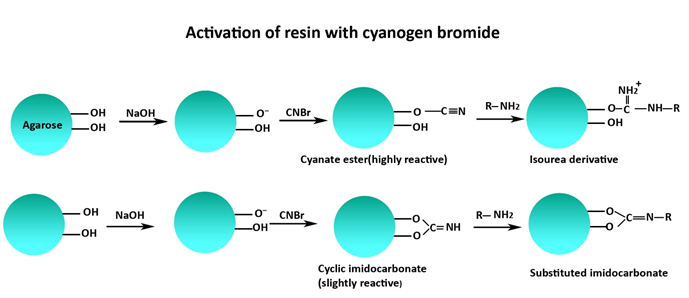Commercially available affinity purification supports are designed on the principle of specific surface interactions among biomolecules, including, but not limiting to, antigen-antibody, enzyme-ligand and lectin-carbohydate. Affinity chromatography is one of the most efficient tools used for purification of biomolecules of interest, including proteins, glycoproteins, lipids and nucleic acids. In affinity chromatography, one of the interacting molecules is covalently bound to the resin and is addressed as a ligand. The stationary ligand bound resin interacts with the ligand interacting proteins or biomolecules, which are passed through the resin in mobile phase and hold them to the resin. These molecules are later eluted as a purified fraction with an elution buffer.
Although many ligand bound resins are commercially available [Concanavalin A (Con A) Agarose, Ni-NTA], they are very specific in the type of protein or biomolecules or affinity tagged protein isolated giving the researcher limited options for using same resin for isolating different proteins or using a ligand of their own choice. To overcome this limitation several pre-activated resins are available [Epoxy-Activated Agarose, CNBr-Activated Agarose].
The resin needs to be preactivated with chemical compounds that enable covalent immobilization of ligand via their functional groups. The resin is usually activated with a compound that is reactive with one or more functional groups including primary amine, thiol, hydroxyl and carboxyl groups. Among them Cyanogen bromide (CNBr) activated agarose is the oldest and still the widely used method for coupling of ligands via their amine groups.
At alkaline pH, cyanogen bromide reacts with the hydroxyl groups on agarose to form cyanate esters or imidocarbonates. These groups readily react with amine groups of ligands under very mild conditions to form covalent bond thereby immobilizing ligand on the agarose support.

CNBr activated agarose offers several advantages:
Simple, rapid and maintains the biological activity of the ligand: CNBr activated coupling of ligand is faster and the coupling takes place under mild pH conditions, thus maintaining biological activity of even the very sensitive biomolecules.
CNBr-activated agarose offers multipoint attachment of protein ligands: CNBr-activated agarose is rich in cyanate esters or imidocarbonates which offers multipoint attachment to protein ligands with their amine groups resulting in chemically stable product.
CNBr-activated coupling work for small and large ligands: CNBr activated agarose is used for binding macromolecules including enzymes, antibodies, antigens etc. CNBr can couple small ligands although it is wise to have a spacer arm as CNBr activated agarose does not provide any spacer arm to avoid steric hindrance.
CNBr-activated coupling has well-proven documented record of being successful technique for purification of large number of proteins: It has been more than 20 years since this coupling techniques is employed by many researchers for purification of antigen, antibodies, enzymes, lectins, glycoproteins etc. As per requirement, the coupling can be scaled up or scaled down.
Limitations: The isourea bond formed between the cyanate ester of the activated resin and amine group of ligand is somewhat unstable resulting in small constant leakage of ligand. The isourea derivative also acts as weak anion exchanger, resulting in non-specific binding. These limitations can be overcome or reduced with careful plan of experiment such as coupling buffer choice, stringent washing and mild elution conditions etc.
It does not provide its own spacer arm and generally is not used for small ligands due to steric hindrance. This limitation can be overcome by providing a spacer between ligand and resin.
CNBr is highly toxic and sensitive to oxidation and so it recommended that a researcher should prefer commercially available CNBr activated resin rather than preparing their own.
Check out other related blogs:






